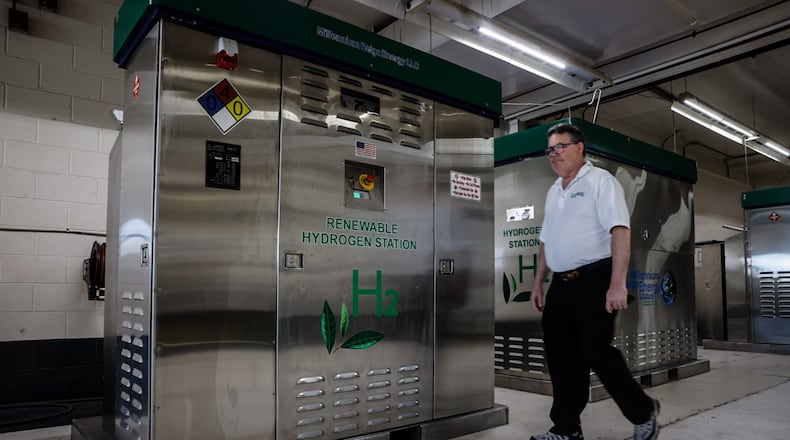“It’s the infrastructure,” McWhinney said in a recent interview. “If you want to build a great business opportunity, you have to find out what’s missing.”
Credit: Jim Noelker
Credit: Jim Noelker
What’s missing is a convenient, cost-effective way to refuel cars with hydrogen fuel cells, produced in a way that matches demand, he believes.
And the infrastructure is crucial. Generators can fuel a hydrogen vehicle in eight to 16 minutes, leaving the vehicle ready to go for 300 miles, the CEO said.
Leaders of the Dayton company, which has offices and production space at 530 N. Main St., in space once occupied by a Cadillac dealership, envisions a scalable range of hydrogen refueling units, with low to high capacity and low to high investment costs.
Millennium has already produced 37 fueling stations or generators that have found homes around the world, from Asia to Europe to California.
And though McWhinney can’t name names, he said his business has ongoing relationships with original equipment manufacturers that are well known nationally, including automakers.
In June, Honda said it is again making fuel cell electric vehicles in at its Performance Manufacturing Center in Marysville.
But market acceptance is a problem. Sales of these vehicles have not been promising so far this year. Sales of the Toyota Mirai and Hyundai Nexo are down in California, according to reports. Honda’s 2025 CR-V e FCEV model, with plug-in capability, is slated to join the market in the second half of the year.
Only 99 hydrogen-fueled vehicles were sold to American buyers in the second quarter this year, down dramatically from about 1,100 sold in the same quarter last year, according to media reports.
Earlier this month, a California law firm said it represents more than 150 Toyota Mirai owners in individual lawsuits against Toyota Motor Corp. over a lack of hydrogen fueling stations.
The technology is still in need of refining, but the idea for been around for decades: Fuel cell electric vehicles — or “FCEVs” — store compressed hydrogen in tanks, charging small batteries, with the only resulting byproducts being water and heat.
An advisor to McWhinney is Dennis Rediker, the former CEO of Standard Register, which was bought by Minnesota’s Taylor Corp. in 2016.
“They provide green electricity and water,” Rediker said, referring to one of Millennium’s generation units. “It generates the hydrogen. It purifies the hydrogen, it compresses it ... it stores it in tanks in back, and it dispenses it into the car — all in a self-contained unit.”
David Cooke, senior associate director of the Ohio State University’s Center for Automotive Research, knows Millenneium Reign Energy well.
“We’ve said for a very long time that hydrogen, the fuel and the power source, has been 20 years away for a hundred years,” he quipped.
It’s “fairly universally accepted” that vehicle fossil fuel emissions need to be reduced, and there are a number of different ways to do that, he said.
“There’s no one answer,” Cooke said.
He believes some of hydrogen’s early successes are most likely to be found in commercial long-haul trucks. EV batteries are a much tougher way to power big trucks, so hydrogen “might really start to shine” in that use, along with perhaps city buses and fleet trucks, Cooke said in an interview.
It can work in passenger cars, as well, he said. But at the moment, “We just don’t have a hydrogen fueling infrastructure.”
Infrastructure poses a chicken-and-egg problem. Investors are reluctant to build the infrastructure while vehicle sales are low. And drivers don’t want to buy the hydrogen vehicles while infrastructure is unreliable or non-existent.
Costs have been a barrier, too.
Cooke credits McWhinney with pursuing “technology disruption” and focusing on costs. “He’s has been from the beginning of his company looking at things differently to drive down costs dramatically.”
In general, Cooke pronounces himself optimistic that hydrogen will eventually find a foothold.
“Really, a lot of this is going to take government support ... I think we’re headed there no matter what,” he said.
About the Author



